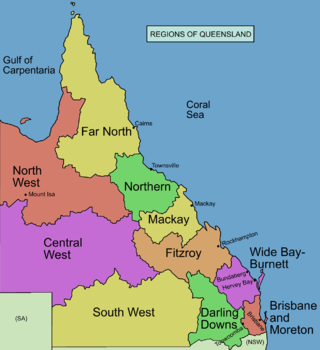The Kalkadoon are descendants of an Indigenous Australian tribe living in the Mount Isa region of Queensland. Their ancestral tribe has been called "the elite of the Aboriginal warriors of Queensland". In 1884 they were massacred at "Battle Mountain" by settlers and police.
Kalkatungu is an extinct Australian Aboriginal language formerly spoken around the area of Mount Isa and Cloncurry, Queensland.
Warluwarra is an extinct Australian Aboriginal language of Queensland. Waluwarra has a traditional language region in the local government area of Shire of Boulia, including Walgra Station and Wolga, from Roxborough Downs north to Carandotta Station and Urandangi on the Georgina River, on Moonah Creek to Rochedale, south-east of Pituri Creek.
Bidjara, also spelt Bidyara or Pitjara, is an Australian Aboriginal language. In 1980, it was spoken by 20 elders in Queensland between the towns of Tambo and Augathella, or the Warrego and Langlo Rivers. There are many dialects of the language, including Gayiri and Gunggari. Some of them are being revitalised and are being taught in local schools in the region. The various dialects are not all confirmed or agreed by linguists.
The Wemba Wemba language is an extinct Aboriginal Australian language once spoken along the Murray River and its tributaries in North Western Victoria and South Central New South Wales.
Warrgamay is an extinct Australian Aboriginal language of northeast Queensland. It was closely related to Dyirbal.
Ngaygungu is a sleeping, Australian Aboriginal language originally spoken by the Ngaygungyi, for which a wordlist was recorded from Atherton in the Wet Tropics of Queensland by Walter Edmund Roth in October 1898, later also recorded by Norman Barnett Tindale in 1938, but no longer spoken by any living speakers.

Western Queensland encompasses the three western regions in the Australian state of Queensland:
Guwa, also spelt Goa, Koa, and other variants, is an extinct and nearly unattested Australian Aboriginal language of Queensland spoken by the Koa people. It was apparently close to Yanda.
The Nguburinji people, also written Ngoborindi, Oborindi and other variations, are an Aboriginal Australian people whose traditional lands lie in northwest Queensland.
Gavan Breen, also known as J. G. Breen, was an Australian linguist, specialising in the description of Australian Aboriginal languages. He studied and recorded 49 such languages.
The Yurlayurlanya, formerly spelt Ulaolinya, were an Indigenous Australian tribe living in the Glenormiston region of South West Queensland.
The Tulua people were an Aboriginal Australian people of Queensland, in the southern to central region from the coast to the ranges. The Dappil and Tulua people possibly spoke the same language.
The Wakabunga are an indigenous Australian people of the state of Queensland.
The Wanggamala people, also spelt Wangkamahdla, Wangkamadla, Wangkamanha, Wangkamana, Wonkamala, Wongkamala, Wonkamudla, and other variants, are an Aboriginal Australian people of the Northern Territory and Queensland.
The Wongkadjera were an indigenous people of the state of Queensland.
The Pitapita or Pitta Pitta are an Aboriginal Australian people of the state of Queensland.
The Yanda were an indigenous Australian people of the state of Queensland.
The Yilba, also written Ilba and Jilba, are or were an Aboriginal Australian people of the present-day state of Queensland.
The Yalarnnga, also known as the Jalanga, are an Indigenous Australian people of the state of Queensland.
